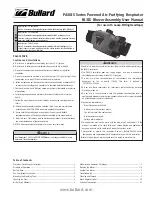
Adjusting and Installing Hard Hat in Respirator
Hood
(20SICH & 20TICH)
1. Assemble and adjust the standard Bullard hard hat suspensions RS4PC or
RS6PC or the optional ratchet suspensions RS4RC or RS6RC by following
the directions on instruction sheet attached to headband on hard hat. Read
all hard hat warning labels and instructions. The following Bullard hard hat
models are approved for use with CC20 Series respirator hoods as part of
a NIOSH approved respirator assembly: C30, C30R,
S51 and S51R.
2. If desired, install and adjust optional ES42 hard hat
chinstrap.
3. Before inserting hard hat into hood, remove the two
adhesive-backed Velcro
®
strips attached to the Velcro
piece that is sewn into the hood (see Figures 10 & 11).
4. Peel the backing off the longer Velcro tab and apply it
to the inside center rear of the hard hat, about 1/4”
up from the edge. Apply shorter Velcro tab to the
underside of the brim of the hard hat (see Figure 10).
5. Insert hard hat into respirator hood with cap visor
facing front of hood (see Figure 11).
6. Tuck cap brim on top of front elastic Velcro band sewn into hood (see Figure
19).
7. Loop the Velcro strip sewn inside the hood around the back of the cap and affix
it to the corresponding Velcro tab previously installed inside the hard hat in
step 4 (see Figure 11).
8. Remove protective plastic from plastic lens of respirator hood. If desired, apply
optional 20LC or 20LCL adhesive-backed lens covers designed to protect the
respirator’s plastic lens. Apply 2-3 lenses at a time. When lens becomes soiled,
remove by pulling tab at edge of lens cover to clear your vision.
Installing Breathing
Tube Assembly in CC20 Hoods
For hoods without a threaded port at the rear, Breathing Tubes PA1BT,
PA1BTXS and PA1BTXL will attach to the hood with a clamp as follows:
1. Remove nylon clamp from plastic anchor plate on hood (see Figure 12).
2. Insert the open end of the breathing tube approximately five inches into
hood’s air entry sleeve (see Figure 13). Do not insert breathing tube into
hood air entry sleeve more than 6 inches as it may cause a flow restriction.
3. Install nylon clamp over air
entry sleeve and breathing
tube, inserting clamp locks
through two holes in plastic
anchor plate that is sewn into
hood. Locks should face away
from user’s neck (see Figure
14). The air entry sleeve
seams should be on the top
and bottom of the breathing
tube when properly installed
and worn.
4. Engage clamp locks and squeeze together until tight. Air entry sleeve should
not be twisted or restricted (see Figure 15). If so, then remove the clamp
and repeat steps 2-4.
For hoods with a threaded port at the rear (designated with a “T” suffix),
Breathing Tubes PAHBT, PAHBTXS, PAHBTXL will attach to the hood by the
threading into the port at the rear (See Figure 13A).
Donning the CC20 and PA30ISBU
1. With PAPR Blower Unit Running, put on CC20 Series respirator hood.
2. Position headband suspension or hard hat for a comfortable fit.
3. If using an optional chin strap, pull elastic strap under
your chin. Adjust for a secure and comfortable fit.
4. Tuck inner bib of hood into shirt or protective clothing
if using hood with inner bib (see Figure 16).
5. Pull respirator outer bib over collar of shirt or
protective clothing.
6. Ensure that the neck cuff is down below the
chin and that the air outlets
of the cuff (see Figure17)
are not restricted. If
the neck cuff is not
below the chin, then
pull down before
continuing (See
Figure
18).
6
CC20 Hood U
se
Figure 9
Velcro strip
Window
Front
elastic
band
Figure 10
Velcro tabs
Velcro
Strip
Figure 11
Figure 12
To tighten
To remove
To tighten
Figure 13A
Figure 13
Figure 14
Twisted – incorrect
Correct
Figure 15
WARNING
Do not put on or remove these respirators in a hazardous atmosphere except for
emergency escape purposes. Failure to heed these warnings could result in death
or serious injury.
Figure 16
Figure 18
Figure 17























